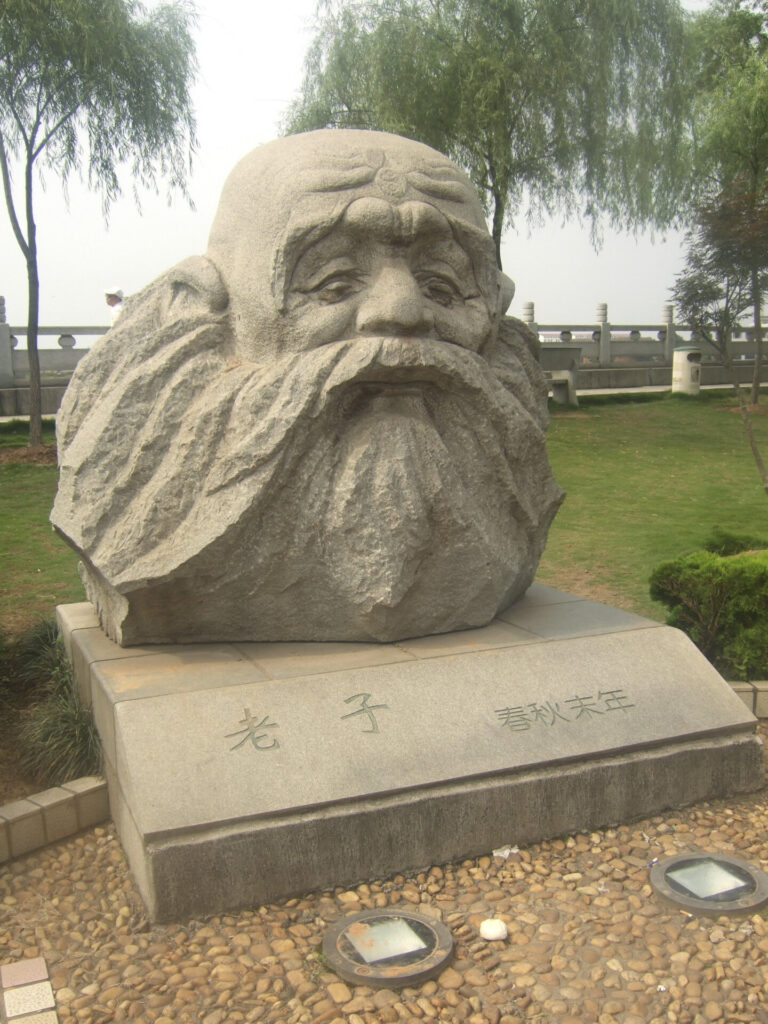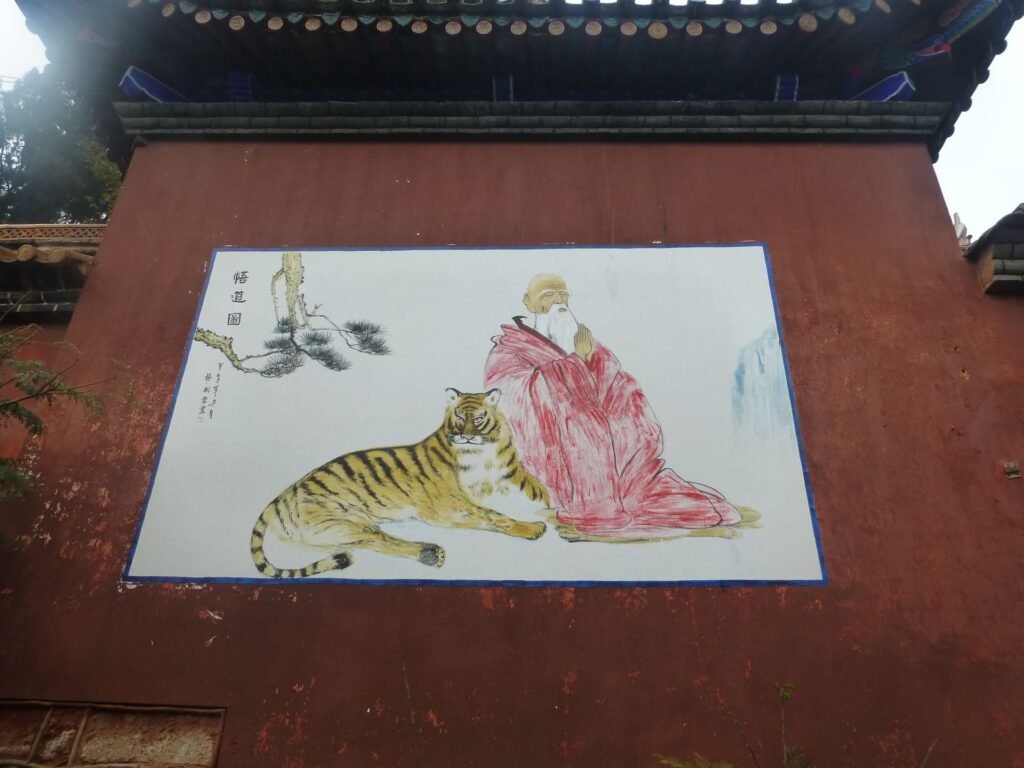
The Way gave birth to the One;
The One gave birth to the Two;
The Two gave birth to the Three;
And the Three gave birth to the ten thousand things.
The ten thousand things carry Yin on their backs and wrap their arms around Yang.
Through the blending of ch’i they arrive at a state of harmony.
The things that are hated by the whole world
Are to be orphaned, widowed, and have no grain.
Yet kings and dukes take these as their names.
Thus with all things – some are increased by taking away;
While some are diminished by adding on.
Therefore, what other men teach,
I will also consider and then teach to others.
Thus, “The strong and violent do not come to a natural end.”
I will take this as the father of my studies.
(Translated by Robert Henricks)
Ho-Shang Kung, quoted by Red Pine, says, “The Tao gives birth to the beginning. One gives birth to yin and yang. Yin and yang give birth to the breath between, the mixture of clear and turbid. These three breaths divide themselves into Heaven, Earth and Man and together give birth to the ten thousand things. These elemental breaths are what keep the ten thousand things relaxed and balanced. The organs in our chests, the marrow in our bones, the spaces inside plants allow these breaths passage and make long life possible.”
Chapter 42 is the only chapter in the Tao Te Ching where the words “yin” and “yang” are found. In the introduction to Yinyang – The Way of Heaven and Earth in Chinese Thought and Culture, Robin Wang writes that the words yin and yang go back to the Shangshu (The Book of History), one of the Five Classics said to have been compiled by Confucius, though the two terms do not appear together, and they only refer to the sunny side (yang) and the shady side (yin) of a mountain. It is only in the Daodejing that yin and yang are associated with the coincidence of opposites. She writes: “The earliest detailed view of this way of thinking appears in the Daodejing, a text expressing thought that probably developed in the 5th century BCE … According to Liang Quichao (1873-1929) … although there is only one use of the term yinyang in the Daodejing, the text has a persistent orientation toward the paradoxical interdependence of opposites in the world.” So, whereas the Daodejing in book form is dated to the 4th century BCE, the teachings of the many authors who contributed to it, goes further back, even perhaps back to the time of Confucius whom, according to tradition, Laozi actually met.
As a word, “qi” (ch’i) goes further back than yinyang, as it has been identified in both the oracle bones of the Shang Dynasty (c. 1600-1046 BCE) and the bronze inscriptions from the Western Zhou Dynasty (12th century-770 BCE). From its original meaning of “vapour,” it had come to take the meaning of life force and become “one of the most basic concepts for explaining change in the natural world.”
Wang says that “The development of qi theory elevated the role of yinyang as the dominant modes of qi, thus as explaining all kinds of natural phenomena. Building on these proto-yinyang sources, an explicit yinyang thought paradigm emerged throughout many texts in the late Warring States Period (475–221 BCE) and early Han Dynasty.” This includes a major turn with the Jixia Academy in 318 BCE and the foundation of the Yinyang School (or School of Naturalists) by Zou Yan (305-240 BCE).
Why, however, is it said that “The ten thousand things carry Yin on their backs and wrap their arms around Yang.”? Lu-Hui-Ch’ing, quoted by Red Pine, answered: “Dark and unfathomable is yin. Bright and perceptible is yang. As soon as we are born, we all turn our backs on the dark and unfathomable yin and turn toward the bright and perceptible yang. Fortunately, we keep ourselves in harmony with the breath between.”
Lines 7 to 11 contain elements pertaining to Chinese culture that obscure their meanings to Western minds. Ames & Hall say that “in ancient times it was customary as a mark of humility for rulers to refer to themselves in first person singular as ‘the friendless’, ‘the unworthy’, and ‘the inept’.” They translate these lines as follows:
“There is nothing in the world disliked more
Than the thought of being friendless, unworthy, and inept,
And yet kings and dukes use just such terms to refer to themselves.
For things, sometimes less is more,
And sometimes, more is less.”
The last four lines may not be clear to all either. Laozi seems to say that he is also going to teach what other people are teaching, which would not be the Daoist view. Ames & Hall translate them as follows:
Thus, as for what other people are teaching,
I will think about what they have to say, and then teach it to others.
For example: “Those who are coercive and violent do not meet their natural end.”
I am going to take this statement as my precept.”
Kao Heng’s comment here is helpful: “According to the Shuoyuan, ‘Tyrants never choose their deaths’ was an ancient saying, which Confucius attributed to Chinjenming. This is what Lao-tzu refers to when he says ‘what others teach.” So is also Wang P’ang’s comment: “Whatever contains the truth can be our teacher. Tyrants kill others and are the most hated of creatures. But we can learn the principle of creation and destruction from them.”
So, the Daoist sage will use what he learned from (Confucian) teachers to teach what is contained in the four first lines, that is, “the inseparability of the one and the many, of continuity and multiplicity,” which was also the theme of chapter 25. Dao is both proliferation and continuity. Proliferation as differentiation of the one into the many (the ten thousand things) and continuity as the reintegration of the many into the one. Ames & Hall write: “Since the proliferation of things are constitutive of dao and continuous with each other, they can be viewed several different ways: In their flux and flow they are ‘passing (shi)’, in their proliferation into distinct and unique particulars they are ‘distancing (yuan)’, and in their radical contextuality and continuity with other things they are ‘returning (fan)’.”
To the process of “returning,”- “reversal” in Henricks’ translation – chapter 40 adds that of “weakening”:
Chapter 40
“Reversal” is the movement of the Tao;
“Weakness” is the function of the Tao.
The things of the world originate in being.
And being originates in nonbeing.
Following the phase of becoming increasingly determinate, Ames & Hall explain, “the ‘thing’ or ‘event’ emerges within its already determinate context. Culminating in its full maturation, the event then begins its gradual process of decline. As the journey continues, any persisting determinate aspects are ultimately weakened and overtaken by indeterminacy, concluding this sojourn into determinacy by its return to the indeterminate … Just as being born is a certain death sentence, any phenomenon or event in its first steps on this journey toward consummation has set off on the road home … And its optimum potency is not in its consummation, but in its initial generation … It is at the moment of setting out as a newborn infant that a person has maximum potency. Thus, the journey can fairly be characterized both as a returning and a gradual weakening of one’s initial promise.”
Sources:
Robert G Henricks – Lao-Tzu, Te-Tao Ching
Red Pine (Bill Porter) – Lao-tzu’s Taoteching
Robin Wang – Yinyang – The Way of Heaven and Earth in Chinese Thought and Culture
Roger T Ames and David L Hall – A philosophical Translation – Dao De Jing – Making this Life Significant”

